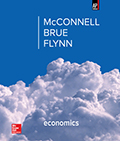Economics (McConnell), AP* Edition, 20th EditionChapter 29:
The Aggregate Expenditures Model After studying this chapter, you should be able to: LO 29.1 | Explain how sticky prices relate to the aggregate expenditures model. | LO 29.2 | Explain how an economy's investment schedule is derived from the investment demand curve and an interest rate. | LO 29.3 | Illustrate how economists combine consumption and investment to depict an aggregate expenditures schedule for a private closed economy and how that schedule can be used to demonstrate the economy's equilibrium level of output (where the total quantity of goods produced equals the total quantity of goods purchased). | LO 29.4 | Discuss the two other ways to characterize the equilibrium level of real GDP in a private closed economy: saving = investment, and no unplanned changes in inventories. | LO 29.5 | Analyze how changes in equilibrium real GDP can occur in the aggregate expenditures model and describe how those changes relate to the multiplier. | LO 29.6 | Explain how economists integrate the international sector (exports and imports) into the aggregate expenditures model. | LO 29.7 | Explain how economists integrate the public sector (government expenditures and taxes) into the aggregate expenditures model. | LO 29.8 | Differentiate between equilibrium GDP and full-employment GDP and identify and describe the nature and causes of "recessionary expenditure gaps" and "inflationary expenditure gaps." |
 | 




